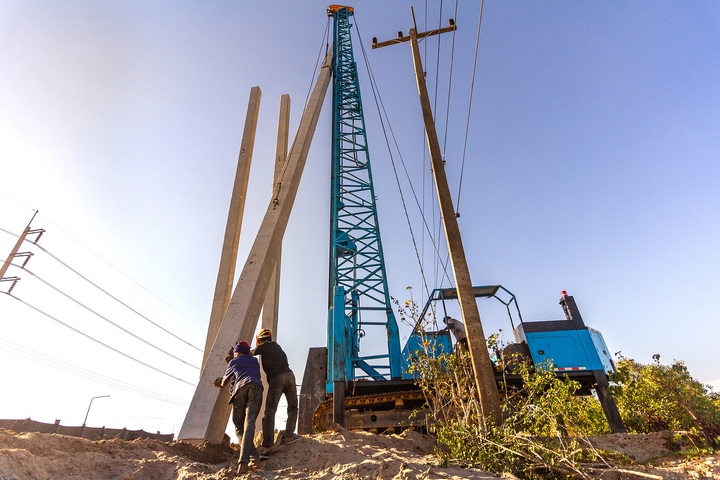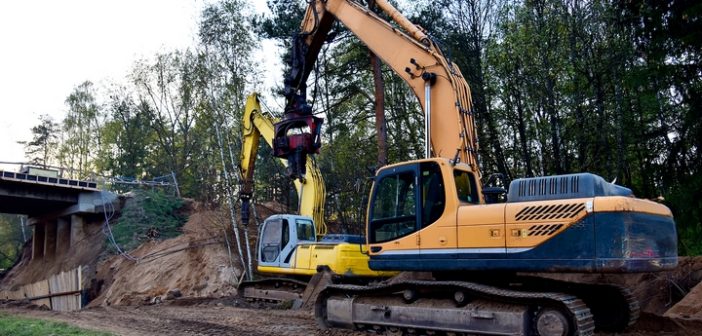When it comes to a structure, most people will see the structure itself as the star of the show, but the one thing that’s truly holding it all together is the foundation at the bottom of it. Without a sturdy foundation, the whole shebang would collapse, tilt, or fall shortly after being built.
There are different types of foundations, one of which is foundation piling. Here is more information about how do foundation piles work:
What is foundation piling?
 Although there are many different types of piles, and a variety of methods that all fall under the style of foundation piling, the basic concept remains the same. Piles are typically long cylindrical pieces that are placed or driven deep into the ground at the base of a structure.
Although there are many different types of piles, and a variety of methods that all fall under the style of foundation piling, the basic concept remains the same. Piles are typically long cylindrical pieces that are placed or driven deep into the ground at the base of a structure.
These contribute to the redistribution of the structure’s load, helping to ensure a sturdy base, especially when the structure is extremely heavy, uneven, tall, or when the soil underneath is inadequate as a foundation. Foundation piling is used in a variety of construction projects including the construction of bridges and skyscrapers.
Cast in-situ piling
 One of the methods of foundation piling is called cast in-situ. Essentially what this means is that the piles are cast in place, not driven in like in other methods. In these cases, a hole is dug equal to the depth of the pile. Reinforcements may be installed to strengthen the concrete’s load-bearing abilities. Then, concrete is poured into the hole that has been dug to create a pile.
One of the methods of foundation piling is called cast in-situ. Essentially what this means is that the piles are cast in place, not driven in like in other methods. In these cases, a hole is dug equal to the depth of the pile. Reinforcements may be installed to strengthen the concrete’s load-bearing abilities. Then, concrete is poured into the hole that has been dug to create a pile.
When this method is used, it is favoured because the pile does not become damaged due to its being driven into the ground. It is also favoured because the piles don’t need to be transported after being fabricated. This method is also significantly quieter than other methods, and may be preferred for that reason.
Driven piles
 The other main type of piles are driven piles. These are precast piles which have been fabricated off-site and transported to the construction site. Typically they are made of concrete or steel, but can also be made of wood. Using a pile driver, the piles are pounded into the ground. There are different types of pile drivers depending on the environment and the pile driving needs.
The other main type of piles are driven piles. These are precast piles which have been fabricated off-site and transported to the construction site. Typically they are made of concrete or steel, but can also be made of wood. Using a pile driver, the piles are pounded into the ground. There are different types of pile drivers depending on the environment and the pile driving needs.
Depending on the reason for using piles in the first place, driven piles may be preferred over cast in-situ piles. One reason is because they can be fabricated in advance of the work being done, and are therefore ready to install whenever they’re needed, thus speeding up workflow. They are also favoured when the structure occurs over water.
Driven and cast in-situ piles
 There is on method for installing piles that demonstrates the best of both worlds. Driven and cast in-situ piles are created by driving a hollow pile into the ground, then subsequently filling it with concrete and reinforcements.
There is on method for installing piles that demonstrates the best of both worlds. Driven and cast in-situ piles are created by driving a hollow pile into the ground, then subsequently filling it with concrete and reinforcements.
It is extremely important that the driven in shell be inspected before the concrete is poured. Any imperfections could cause issues in the flow of concrete, thus creating a pile that is structurally compromised.
End bearing piles
 Piles can also be used differently, depending on how the load needs to be distributed. End bearing piles are piles that transfer the weight of the structure onto the bottom end of the pile. For instance, when creating a pile foundation for a bridge, the pile needs to surpass the water and the upper layer of the soil, and settle on solid soil far below the surface. The pile will transfer the weight of the superstructure onto the very bottom of the pile that is resting on strong soil.
Piles can also be used differently, depending on how the load needs to be distributed. End bearing piles are piles that transfer the weight of the structure onto the bottom end of the pile. For instance, when creating a pile foundation for a bridge, the pile needs to surpass the water and the upper layer of the soil, and settle on solid soil far below the surface. The pile will transfer the weight of the superstructure onto the very bottom of the pile that is resting on strong soil.
Friction bearing piles
 These piles are able to redistribute the load throughout the entire surface of the pile. Essentially, the compaction of the soil surrounding the pile creates a strong foundation. The load bearing amount of friction bearing piles – also known as floating piles – is directly related to how long they are.
These piles are able to redistribute the load throughout the entire surface of the pile. Essentially, the compaction of the soil surrounding the pile creates a strong foundation. The load bearing amount of friction bearing piles – also known as floating piles – is directly related to how long they are.
These are used when it is not possible to reach the strong soil beneath the ground, possible because it is too far beneath the surface. Although they do not rest on solid soil, they still provide a strong foundation using the compaction of the surrounding soil.
Pile drivers
 For a lot of pile foundations, pile drivers are the star of the show. Whenever driven piles are used for a structure, the pile drivers must be used to install them. Hydraulic, diesel impact, vibratory, and air or stream impact hammers are the most commonly used types of pile drivers. Each has it’s own advantages.
For a lot of pile foundations, pile drivers are the star of the show. Whenever driven piles are used for a structure, the pile drivers must be used to install them. Hydraulic, diesel impact, vibratory, and air or stream impact hammers are the most commonly used types of pile drivers. Each has it’s own advantages.
For instance, hydraulic impact hammers and air or steam impact hammers are well-liked for being more environmentally friendly than diesel hammers. Hydraulic impact hammers are a modern version of the diesel, but diesel impact hammers are often preferred as they are renowned for their reliability. Vibratory hammers are great when noise is a concern.




